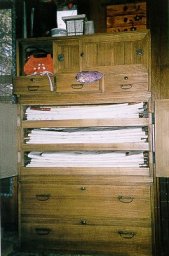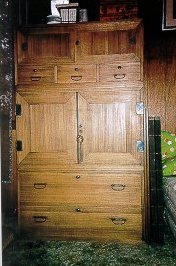If there is one single piece of clothing that is associated with Japan, it is the kimono (literally translated as "the thing worn.") The kimono and its variations has a very long history in Japan and is still worn today, although generally only for celebrations and wedding ceremonies. The history of the development of the kimono is closely tied to the development of Japanese textiles and techniques for making clothing.
The kimono emphasizes the material from which it is made. Assembled from simple rectangular cut pieces of cloth, the shape of the body is both concealed and virtually ignored by the structure of the garment. Western clothing is constructed of material that is cut precisely to conform to and accentuate the shape of the body, thus eliminating the space between body and garment.
The kimono is made by sewing together simple rectangles cut in straight lines from relatively narrow widths of hand woven silks or hemp tailoring, such as that found in western style garments is not used. This makes it easy to take the kimono apart, replace worn areas, and put it back together again.
Kimonos and relatives during certain time periods:
The Joman, Yayoi and Tumulus Periods
The Asuka era
The Nara era
The Heian era
The Kamakura era
The Muromachi era
The Momoyama era
The Edo period
The Meiji era
Later eras
Making the kimono
There were different ways of decorating the kimono. Among these are:
Immersion dyeing: This is used when you want the entire cloth to be of the same color. Once the dye is ready the cloth is immersed in it over and over until you get the exact color that you want. Once that happens the cloth is removed and dried. Sometimes certain materials are used to make sure the dye penetrates the cloth properly.
Painting: You outline a pattern, then use dyes and mordents to brush in the pattern and then use freehand painting to finish it.
Paste resist: A drawing of the design is made on the fabric, then past is applied to the area to be reserved and then the dyeing is done.
Shibori: Sometimes there are areas of the cloth that you don't want dyed at first, so it's necessary to somehow block off those areas from the dye when you initially immerse it in the dye bath.
Yuzen dyeing: The silk is stretched straight then a drawing is painted onto the white silk with a water-soluble blue liquid. The drawing is traced over with narrow lines of resist paste. The name comes from Miyazuki Yuzensai, a fan painter of the seventeenth century.
Kimono colors
It is obvious that on many of the kimonos color is a very important aspect. Through the Heian period colors were considered to have a spiritual force. Many of the plants used for dyes for the kimonos also had medicinal uses, adding even more importance to the colors used.
Color names include murasaki (purple); akane (red); ai (indigo); benibana (scarlet) and cha, or brown.
Black, which was associated with wisdom, was believed to be protection against evil. Purple represented elegance and was connected with the highest ranks of people. Browns and greys were the traditional colors for commoners.
Storing the Kimono
Since kimonos are constructed so that they can be taken apart and put back together there have been times when a kimono that had faded was taken apart, re-dyed and then put back together again although this is not really done much anymore.
Kimonos are also never dry cleaned. You also never hang the kimono on a hanger or seal it in plastic.
In order to clean you first shake off any dust and then vacuum the surfaces to remove any other dust. You then refold the kimono and put it away.
Properly storing a kimono requires wrapping it in rice paper called tatoushi then laying the kimono flat in a drawer. Ideally this would be something called a kiri tansu which is a chest made of lightweight wood that repels moisture.


More information on kimonos can be found in these sections:
Children's kimonos
Furisodes
Kimonos in general
Haori
Tomesodes
Uchikake
Yukata



